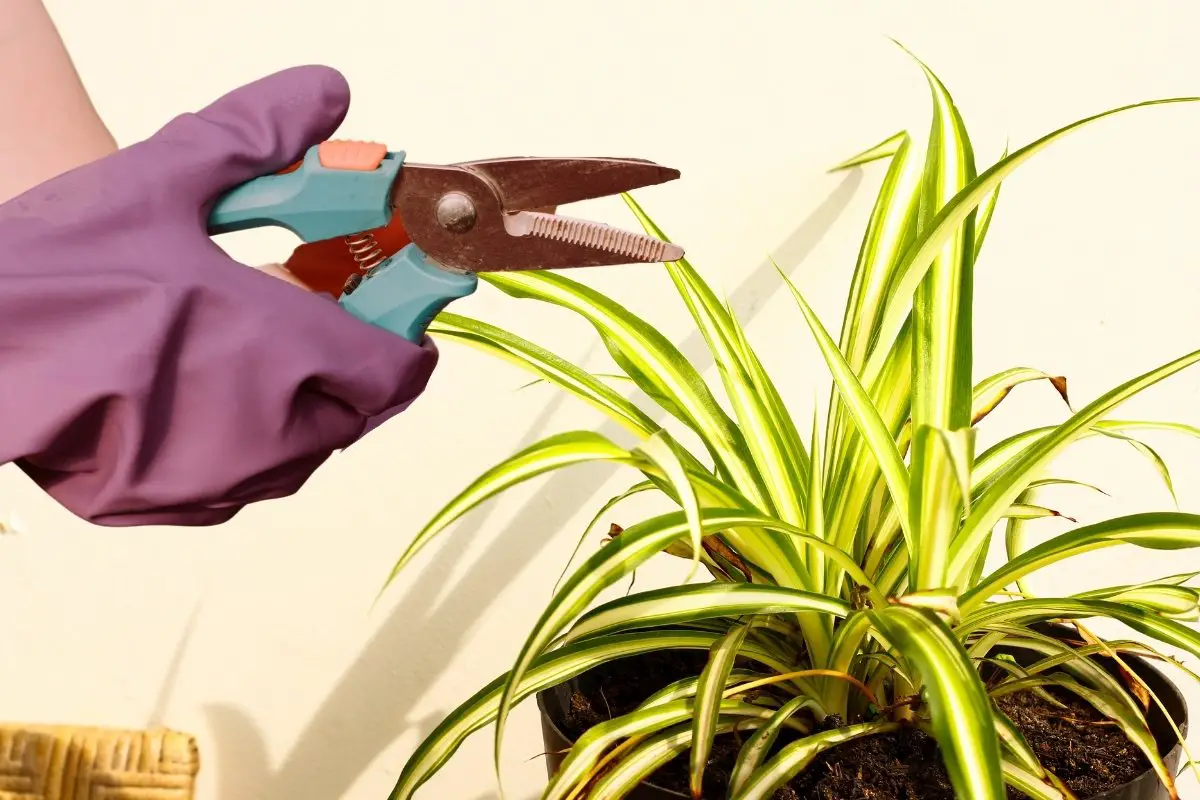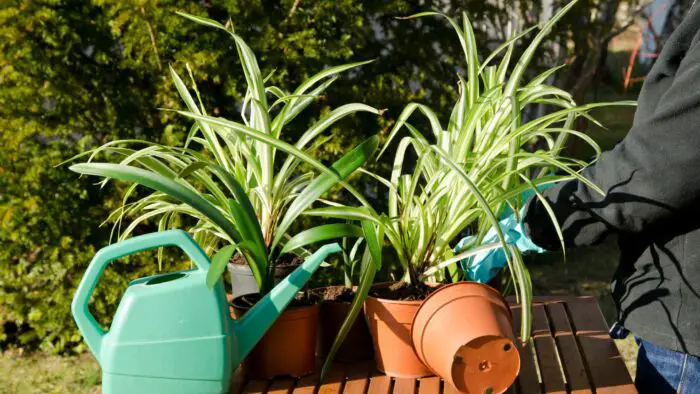Last Updated on March 10, 2023 by Griselda M.
When it comes to trimming spider plants, there are a few things that you need to know to do it properly. Growing a spider plant as a houseplant is relatively easy, even for those with a brown thumb, but you need to know how and when to trim them for the best result. The spider or ribbon plant is well-known for its thin, long, and bouncy leaves. While they make a great impression at first sight, they require regular maintenance to grow their best.
Trimming and pruning tend to scare beginner gardeners. But it’s way more simple than you might think! Removing spider plantlets and dead leaves allows your plant to get more nutrients and grow into an admirable eye-catcher. We have a simple, foolproof guide on how to keep your spider plant tidy and healthy. Let’s dive into it so you understand what your plant needs to thrive.
Is Trimming Spider Plants Necessary?
When you keep postponing a trim, your hair tends to get messy and unruly, and split ends appear. Think the same way about your spider plant. Unregular trimming leads to unruly leaves, spiderettes growing from all sides, and the main plant might hit a stagnant period. Regular trimming rejuvenates your older spider plant, keeping it healthy and thriving for years ahead.
The primary reason to learn how to trim spider plants is not their appearance. Although brown leaves need to be removed as soon as possible, the root and spiderettes also need trimming from time to time.
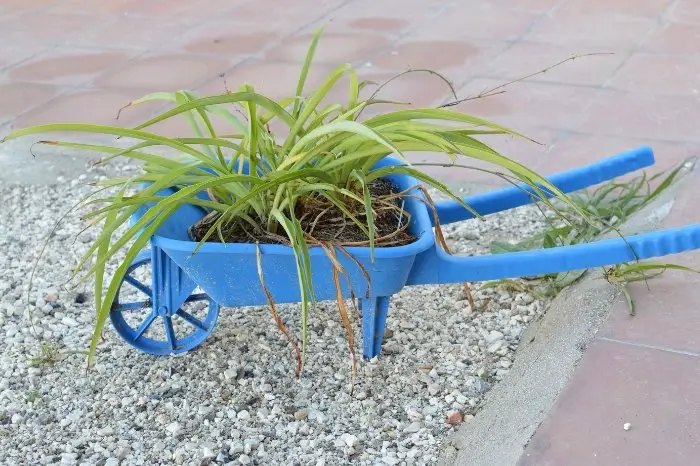
The spider plantlets use all the moisture and nutrients from the soil. You don’t notice any change even after you fertilize the spider plant? That’s because the spiderettes intake all the available food. Therefore, knowing how to trim a spider plant is an essential part of its care and maintenance.
Best Time to Trim Spider Plant Leaves
Trimming the leaves of the spider plants is necessary, and it should be done once a year, preferably in spring. The same schedule applies to spiderettes or spider plantlets.
You can trim the roots once every 2 years. This is crucial as they’re sensitive to root rot. If you have ever had to deal with root rot, you probably know how to trim spider plant roots already.
Read more about:
How to Trim Spider Plant Leaves?
The leaves of a young spider plant are only 4 to 6 inches long. As it matures, it can reach up to 2 feet in length. The whole plant ends up with a 1 to 2 feet diameter. This makes it challenging to manage.
One of the reasons why your spider plant becomes leggy is the lack of trimming. Remember that healthy spider plant leaves are dark green with a white stripe in the middle, lengthwise. So, how to trim spider plants?
-
-
Start by disinfecting a pair of sharp garden scissors or shears.
-
Cut damaged, yellow leaves and the ones that have brown tips. Spider plant leaves don’t have stems, so you would have to trim them closer to the ground.
-
If the plant is too leggy, cut healthy leaves that grow near the base of the plant.
-
If you removed a large part of the foliage, you could skip the following year’s trimming.
-
Why Do Spider Plant Leaves Turn Yellow?
Spider plant leaves can turn yellow even if the plant seems to be completely healthy. Too much fertilizer or excess minerals in the water can yellow the leaves. City tap water is rich in chlorine and other chemicals which accumulate in the soil. They make their way into the foliage and damage the leaves.
To prevent this from happening, water your plant with demineralized or rainwater. Repot the plant once a year in entirely new soil. And, of course, understand how to trim spider plant-damaged leaves.
How to Prune Spider Plant Spiderettes?
A mature and healthy spider plant grows thin hanging stems from the center. Small spider plants are attached at the tips of these stems. The tiny spider plants hanging from your main plant are called spiderettes or plantlets.
But they’re not all good. The baby plants need nutrients to grow. When there’s a large number of spiderettes, the main plant droops. This is because the spider plantlets take away necessary nutrients from the main plant.
Here’s how to trim a spider plant baby plants:
-
-
Take a pair of clean and sharp shears. Pick which baby plants to remove.
-
Cut the stem in the middle between the baby and the main plant.
-
If you want to remove the stem altogether, trim at the base as near to the soil as possible.
-
If you want to propagate the spiderette, remove the stem.
-
Ocean Spider Plant – Easy to Grow – Cleans The Air – New – 3 Pack
Propagating spiderettes
When removing older spider plant babies, they might have already developed roots. Place these plants in pots 4 to 5 inches wider than the plant. Fill with well-draining soil and water thoroughly. The new plant should establish and develop new growth in a few weeks.
Check Out How Do I Keep My Snap Peas Producing All Year?
How to Trim Spider Plant Roots?
Spider plants tend to get root bound. The rootbound plant doesn’t get enough nutrients and has stunted growth. So, if you notice the spider plant leaves turning yellow soon after trimming, it’s best to shorten the roots.
Repotting and trimming are both best done in spring. Carefully learn how to trim spider plant roots since a poor trim will damage the plant.
-
-
Remove the plant from the previous pot. Shake off excess soil so you can reveal the roots.
-
Start by carefully trimming the outside and bottom roots. Don’t cut more than 1 inch.
-
Check for dark, soft, and mushy roots and remove any. They’re a sign of root rot.
-
Sterilize the shears so you won’t transmit any pathogens to your other plants.
-
Benefits of Pruning Your Spider Plants
Once you decide to get a spider plant, you must learn how to trim spider plant leaves, baby plants, and roots. Regular trimming contributes to healthier and well-developed plants.
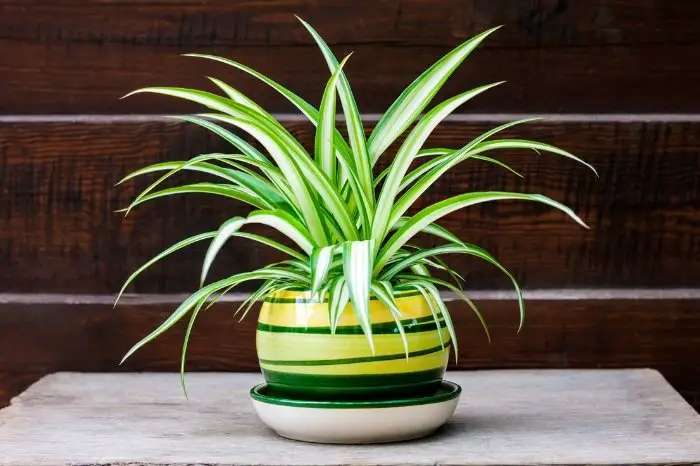
Trimming reduces the need for fertilizer as the plant doesn’t consume that much energy. Brown and damaged leaves don’t provide food for the plant, so by removing them, you improve the health and appearance of the plant.
How Many Babies Does a Spider Plant Have?
This will depend on the size of the plant, growing conditions and the quality of the soil, the amount of light, and so on. I have one spider plant now that is growing in a big pot, and it has so many babies dangling over the side that I cannot even count them. These plants can produce ten or fifteen babies that will dangle over the edge of the pot every few months if they are grown in optimal conditions. Further down, you can see a picture of my mother’s spider plant – she just produces babies in clouds all the time. Gets a bit irritating after a while.
How to Transplant a Spider Plant Shoot?
The best way is just to place the baby spiderette in a new pot, let it root, and then clip the stem connecting it to the mother plant. If you cannot do this, clip a little spiderette with roots and place it in a new pot. Be careful to keep the soil moist, and it will take root as expected.
I normally trim a few of the bigger leaves off the spiderette, as this can sometimes allow it to recover from the shock of losing the connection to the mother plant. This connection would have shunted nutrients and water to the new plant. If your spider plant does not have enough water absorbed through its young roots, it can end up having trouble maintaining the bigger leaves. Hence removing these enhance transplant success.
What Can You Plant With a Spider Plant?
Spider plants grow low and cover the base of a pot. Any larger plant that grows up will do very well. I have spider plants below my potted curry plants – this is to keep the soil moisture balanced as curry plants drown easily.
What Can I Do With an Overgrown Spider Plant?
Trim it. I normally just go in and remove a few plants from the clump and transplant them. If you give the plant a haircut around the edges, taking off all the little hanging spiderettes can help them look better too. Sometimes it is nice to have a yeti spider plant that is just a big shaggy disaster. Other times not. If you do not need more spider plants, you can dispose of the extra plants in the trash or feed them to your chickens.
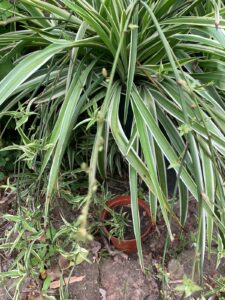
How Much Humidity Do Spider Plants Need?
If you read around on the internet, a lot of people call spider plants tropical plants. They are not, actually, although they do grow in the tropics. Much of their growth range is actually characterized by long periods of low humidity – that is why they have waxy leaves and water-storage roots. I have found they thrive in a range of climates that reach plus or minus 10% or around 60% humidity. My plants are often exposed to periods of really low humidity; however, they continue to thrive. I think that an ideal supply of light and proper watering is probably far more important for these plants than humidity levels.
Can You Cut the Dead Ends off a Spider Plant?
So, can you cut the dead ends off a spider plant? In general, it is not always necessary to cut back spider plants. This is because these hardy plants are quite resilient and can grow well if afforded minimal care. However, you can cut off the dead ends of the plant to prevent the formation of poisonous seeds that appear when withered foliage is left unattended. Aside from that, pups or spiderettes which are offshoots can also be cut off to propagate new spider plants.
It is also essential to get to the bottom of the problem that is causing your plant to deteriorate and wither before pruning. This will give you a fair idea of whether a larger proper like root rot or infestations exists, which is usually not seen with the naked eye. With some snake plants, aside from cutting them back to restore them to their former glory, repotting may be necessary for this instance. However, keep in mind that trimming spider plants before transferring them would prove beneficial.
Additionally, you should look out for signs of browsing on your spider plant leaves. Sometimes you may find that the tips are brown instead of the entire leaf. Remember that you should pluck any leaves that show signs of deterioration, as it will enhance your plant’s growth and produce new foliage.
Should I Cut the Flowers off My Spider Plant?
I have often been asked by avid gardeners, if should I cut the flowers off my spider plant. Generally, the withered blooms on your spider plant should be cut off, as this will stop them from seeding. The reason it is good to stop the seeding process is that they are poisonous. Therefore, most indoor and outdoor gardens are for trimming spider plants.
But, some gardeners don’t remove the flower buds and actually use bloom boosters to enhance them. These fertilizers work best when applied during the spring season, especially if you have a blooming spider plant which is not always the case.
Also, spend flowers produce green pods, which seeds can be collected from after they have turned brown. Small plantlets are also formed from leaves that are produced at the stem ends after the flowering season. Pollinated spider plant flowers are known to produce a fruit that contains black seeds in a capsule-like casing.
Can You Plant Spider Plant Tubers?
Can you plant spider plant tubers? To begin, you would first need to understand what these tubers are and how they grow. The thick clusters that you see growing along the roots of your spider plants usually manifest themselves in chaotic masses. They grow quite rapidly and produce full-grown snake plants when planted in the right conditions. So yes, you can plant spider plant tubers if you want to increase them in your garden. However, correctly propagating these plants is vital for them to thrive.
Here are a few tips to take heed of when planting spider plants in your home or garden:
- When it comes to spider plant tubers, they work as the plant’s reservoir as they store water that sustains them in unfavorable conditions.
- Tubers are also able to reach the surface of the soil once the plants have become root bound.
- If you notice an abundance of tubers, it is advised that you transfer your plant to a larger pot.
- Spider plants can be grown from root cutting, seeds, spiderettes, and tubers and are, therefore, very popular houseplants amongst many locals. A very common way to propagate them is by using their tubers.
- These plants should be grown in a pot that has well-draining soil and holes to get rid of excess moisture.
- After planting your spider plant tubers, you should notice clusters of leaves which usually look like rosettes, that produce the stem of the plant. From these stems, the spider plant sprouts will appear.
- Keep in mind that growing spider plants from tubers will also aid in providing pre-emergence nourishment that is vital to your plant’s growth. This alone enhances the development of the snake plant tenfold.
- Tubers should be planted shallow, which is about an inch or two into the growing medium. However, this will also depend on the size of the snake plant tuber you propagating.
- After planting, you can expect new plant shoots to be visible in a month or a month and a half.
Final Say: When and How to Trim Spider Plants
As a responsible gardener, you need to know how to trim spider plant leaves to keep them healthy. In addition, learning how to trim spider plant spiderettes is very useful if you want to propagate or even gift baby plants to friends and family.
Spider plants have unique leaves that can grow up to 2 feet and become messy, unruly, and eventually yellow. Additionally, sunlight, mineral-rich water, and pests can affect the leaves. Trimming helps you keep up the appearance and well-being of the plant.
When yellow leaves keep on returning, knowing the benefits of trimming spider plants and other useful care and maintenance strategies would be beneficial.
Mary is a passionate gardener who loves spending her days getting her hands dirty and nurturing her plants. She‘s an avid reader of gardening magazines and is always looking for new ways to make her garden thrive. When not outside tending to her plants, Mary can be found inside reading up on the latest gardening trends, comparing notes with fellow gardeners, and finding the perfect pottery planter for her next planting project.

